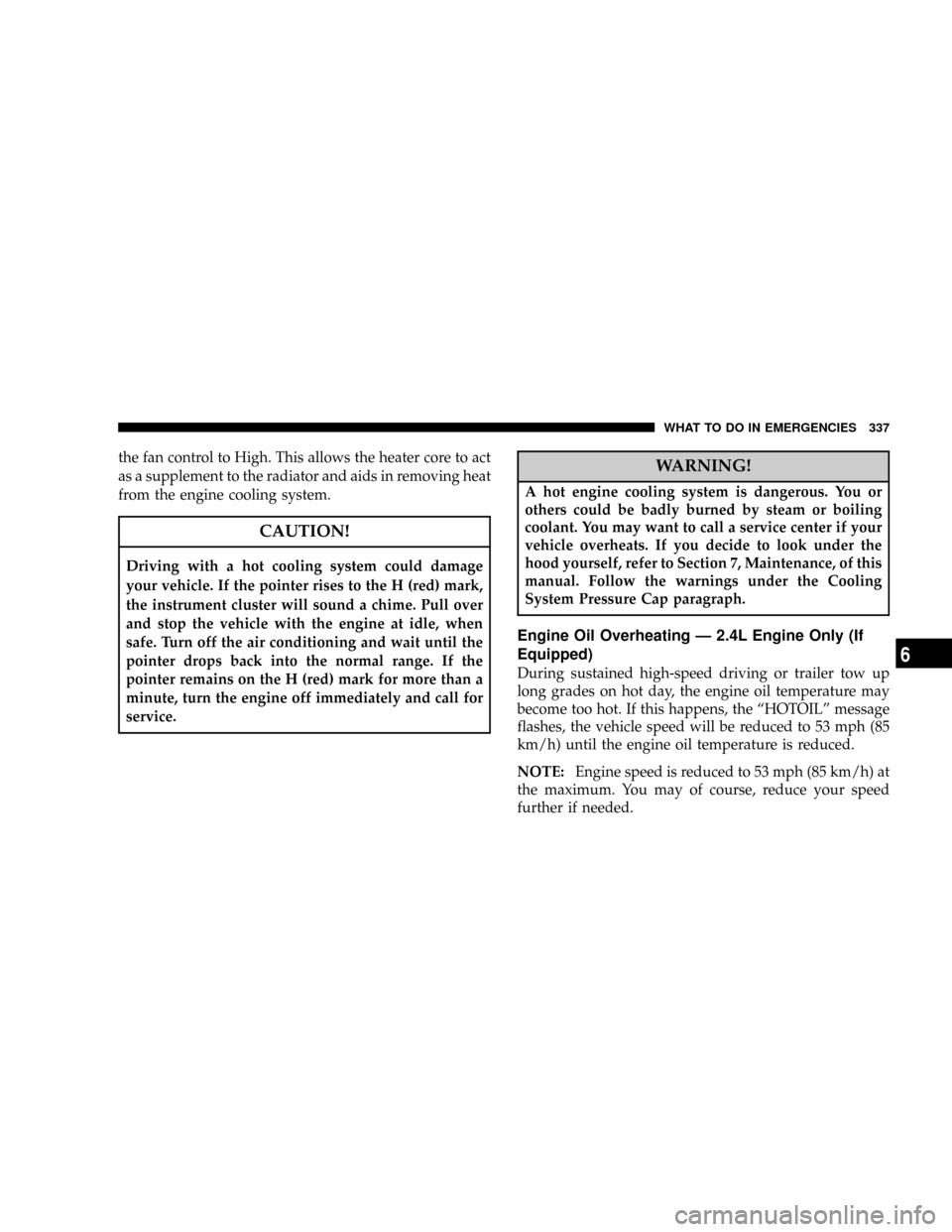oil temperature CHRYSLER SEBRING CONVERTIBLE 2008 3.G Owners Manual
[x] Cancel search | Manufacturer: CHRYSLER, Model Year: 2008, Model line: SEBRING CONVERTIBLE, Model: CHRYSLER SEBRING CONVERTIBLE 2008 3.GPages: 454, PDF Size: 5.8 MB
Page 178 of 454

will turn off after the engine is started. If the bulb does
not come on during starting, have the system checked by
an authorized dealer.
If the light comes on and remains on while driving, stop
the vehicle and shut off the engine. DO NOT OPERATE
THE VEHICLE UNTIL THE CAUSE IS CORRECTED.
The light does not show the quantity of oil in the engine.
This can be determined using the procedure shown in
Section 7.
11. Engine Temperature Warning Light
This light warns of an overheated engine condi-
tion. If the engine is critically hot, a warning chime
will sound 10 times. After the chime turns off, the
engine will still be critically hot until the light goes out.12. Tachometer
The white area of the scale shows the permissible engine
revolutions-per-minute (rpm x 1000) for each gear range.
Before reaching the red area, ease up on the accelerator to
prevent engine damage.
13. Transmission Range Indicator
This display indicator shows the automatic transaxle gear
selection.
14. Odometer/Trip Odometer
The odometer shows the total distance the vehicle has
been driven. U.S. federal regulations require that upon
transfer of vehicle ownership, the seller certify to the
purchaser the correct mileage that the vehicle has been
driven. Therefore, if the odometer reading is changed
during repair or replacement, be sure to keep a record of
the reading before and after the service so that the correct
mileage can be determined.
178 UNDERSTANDING YOUR INSTRUMENT PANEL
Page 314 of 454

For best results, a refueling pattern that alternates be-
tween E-85 and unleaded gasoline should be avoided.
When you do switch fuels, it is recommended that:
²you do not switch when the fuel gauge indicates less
than1¤4full
²you do not add less than 5 gallons when refueling
²you operate the vehicle immediately after refueling for
a period of at least 5 minutes
Observing these precautions will avoid possible hard
starting and/or significant deterioration in drivability
during warm up.
NOTE:When the ambient temperature is above 90É F
(32É C), you may experience hard starting and rough idle
following start up even if the above recommendations are
followed.
Selection Of Engine Oil For Flexible Fuel Vehicles
(E-85) and Gasoline Vehicles
FFV vehicles operated on E85 require specially formu-
lated engine oils. These special requirements are included
in Mopartengine oils, and in equivalent oils meeting
DaimlerChrysler Specification MS-6395. The manufac-
turer only recommends engine oils that are API Certified
and meet the requirements of Material Standard MS-
6395. MS-6395 contains additional requirements, devel-
oped during extensive fleet testing, to provide additional
protection to DaimlerChrysler Corporation engines. Use
Mopartor an equivalent oil meeting the specification
MS-6395.
NOTE:Your engine oil filler cap also describes the
correct engine oil to use.
314 STARTING AND OPERATING
Page 337 of 454

the fan control to High. This allows the heater core to act
as a supplement to the radiator and aids in removing heat
from the engine cooling system.
CAUTION!
Driving with a hot cooling system could damage
your vehicle. If the pointer rises to the H (red) mark,
the instrument cluster will sound a chime. Pull over
and stop the vehicle with the engine at idle, when
safe. Turn off the air conditioning and wait until the
pointer drops back into the normal range. If the
pointer remains on the H (red) mark for more than a
minute, turn the engine off immediately and call for
service.
WARNING!
A hot engine cooling system is dangerous. You or
others could be badly burned by steam or boiling
coolant. You may want to call a service center if your
vehicle overheats. If you decide to look under the
hood yourself, refer to Section 7, Maintenance, of this
manual. Follow the warnings under the Cooling
System Pressure Cap paragraph.
Engine Oil Overheating Ð 2.4L Engine Only (If
Equipped)
During sustained high-speed driving or trailer tow up
long grades on hot day, the engine oil temperature may
become too hot. If this happens, the ªHOTOILº message
flashes, the vehicle speed will be reduced to 53 mph (85
km/h) until the engine oil temperature is reduced.
NOTE:Engine speed is reduced to 53 mph (85 km/h) at
the maximum. You may of course, reduce your speed
further if needed.
WHAT TO DO IN EMERGENCIES 337
6
Page 362 of 454

CAUTION!
Do not overfill the engine. Overfilling the engine
will cause oil aeration, which can lead to loss of oil
pressure and an increase in oil temperature. This
could damage your engine.
Change Engine Oil
The oil change indicator system will remind you that it is
time to take your vehicle in for scheduled maintenance.
Refer to ªMaintenance Scheduleº in Section 8 of this
manual for information on this system.
NOTE: Under no circumstances should oil change
intervals exceed 6,000 miles (10 000 km) or 6 months,
whichever occurs first.
Engine Oil Dipstick
362 MAINTAINING YOUR VEHICLE
Page 363 of 454

Engine Oil Selection
For best performance and maximum protection under all
types of operating conditions, the manufacturer recom-
mends engine oils that are API Certified and meet the
requirements of DaimlerChrysler Material Standard MS-
6395.
American Petroleum Institute (API) Engine Oil
Identification Symbol
This symbol means that the oil has
been certified by the American
Petroleum Institute (API). The
manufacturer only recommends
API Certified engine oils.
Engine Oil Viscosity (SAE Grade) Ð 2.4L and 2.7L
Engines
SAE 5W-20 engine oil is recommended for all operating
temperatures. This engine oil improves low temperature
starting and vehicle fuel economy. Your engine oil filler
cap also shows the recommended engine oil viscosity for
your vehicle.
The engine oil filler cap also shows the recommended
engine oil viscosity for your engine. For information on
engine oil filler cap location, refer to the ªEngine Com-
partmentº illustration in this section.
Lubricants which do not have both, the engine oil certi-
fication mark and the correct SAE viscosity grade num-
ber should not be used.
Engine Oil Viscosity (SAE Grade) Ð 3.5L Engine
SAE 10W-30engine oil is preferred for all operating
temperatures. The engine oil filler cap also shows the
recommended engine oil viscosity for your vehicle.
MAINTAINING YOUR VEHICLE 363
7
Page 382 of 454

WARNING!
Riding the brakes can lead to brake failure and
possibly an accident. Driving with your foot resting
or riding on the brake pedal can result in abnormally
high brake temperatures, excessive lining wear, and
possible brake damage. You wouldn't have your full
braking capacity in an emergency.
Brake And Power Steering Hoses
When servicing the vehicle for scheduled maintenance,
inspect the surface of the hoses and nylon tubing for
evidence of heat and mechanical damage. Hard and brittle
rubber, cracking, tears, cuts, abrasions, and excessive swell-
ing suggest deterioration of the rubber. Particular attention
should be made to examining those hose surfaces nearest
to high heat sources, such as the exhaust manifold.
Insure nylon tubing in these areas has not melted or
collapsed.Inspect all hose clamps and couplings to make sure they
are secure and no leaks are present.
NOTE:
²Often, fluids such as oil, power steering fluid, and
brake fluid are used during assembly plant operations
to ease the assembly of hoses to couplings. Therefore,
oil wetness at the hose-coupling area is not necessarily
an indication of leakage. Actual dripping of hot fluid
when systems are under pressure (during vehicle
operation) should be noted before a hose is replaced
based on leakage.
²Inspect the brake hoses whenever the brake system is
serviced and at every engine oil change. Inspect hy-
draulic brake hoses for surface cracking, scuffing, or
worn spots. If there is any evidence of cracking,
scuffing, or worn spots, the hose should be replaced
immediately! Eventual deterioration of the hose can
take place resulting in a possibility of a burst failure.
382 MAINTAINING YOUR VEHICLE
Page 433 of 454

Automatic Dimming Mirror................. 96
Automatic Door Locks..................... 31
Automatic Headlights.................... 139
Automatic Oil Change Indicator........179,189,414
Automatic Temperature Control (ATC)......... 237
Automatic Transaxle................251,255,384
Adding Fluid...................384,385,412
Filter............................... 386
Fluid and Filter Changes................. 386
Fluid Level Check...................384,385
Interlock System....................256,257
Reset Mode.......................... 261
Selection Of Lubricant................... 412
Shifting............................. 255
Special Additives...................... 386
Autostick............................. 262
Back-Up Lights......................... 404
Ball Joints............................. 372Battery............................... 367
Emergency Starting..................... 344
Gas Caution.......................... 368
Jump Starting......................... 344
Keyless Transmitter Replacement (RKE)....... 26
Location..........................345,367
Bearings.............................. 387
Belts, Drive............................ 365
Belts, Seat............................40,75
Beverage Holder Cooled (Cup Holder)......... 164
Beverage Holder Heated (Cup Holder)........ 164
Body Mechanism Lubrication............... 372
B-Pillar Location........................ 284
Brake Assist System...................... 275
Brake Control System, Electronic............. 275
Brake Fluid............................ 412
Brake, Parking.......................... 264
Brake System........................267,381
Anti-Lock (ABS)....................... 268
INDEX 433
10
Page 438 of 454

Oil Synthetic......................... 364
Operation............................ 72
Overheating.......................... 336
Starting............................. 251
Temperature Gauge..................... 176
Engine Oil Viscosity...................... 363
Enhanced Accident Response Feature.......... 58
Entry System, Illuminated.................. 20
Ethanol............................... 309
Event Data Recorder...................... 60
Exhaust Gas Caution................74,311,375
Exhaust System.......................74,374
Extender, Seat Belt........................ 48
Exterior Light Service..................... 401
Exterior Lights........................76,401
Fabric Care.........................389,390
Filler Location Fuel....................176,316Filters
Air Cleaner.......................... 365
Air Conditioning....................244,370
Automatic Transaxle.................... 386
Engine Oil........................365,410
Engine Oil Disposal.................... 364
Flashers
Hazard Warning....................... 336
Turn Signal........................76,142
Flash-To-Pass........................... 143
Flat Tire Changing....................... 338
Flat Tire Stowage........................ 344
Flexible Fuel Vehicles..................... 312
Cruising Range........................ 315
Engine Oil........................... 314
Fuel Requirements..................312,313
Maintenance.......................312,315
Replacement Parts..................... 315
Starting............................. 315
438 INDEX
Page 443 of 454

Engine Temperature Warning.............. 178
Exterior.............................. 76
Fog ..........................141,183,403
Hazard Warning Flasher................. 336
Headlight Switch...................138,139
Headlights........................139,401
Headlights On Reminder................. 141
Headlights On With Wipers............139,148
High Beam........................142,401
High Beam Indicator.................... 186
High Beam/Low Beam Select............. 142
Illuminated Entry....................... 20
Instrument Cluster..................... 138
Intensity Control....................... 144
Interior............................. 144
License............................. 407
Lights On Reminder.................... 141
Low Fuel............................ 177
Malfunction Indicator (Check Engine)........ 186Map Reading......................... 144
Oil Pressure.......................... 177
Parade Mode (Daytime Brightness).......... 145
Park.............................138,139
Passing............................. 143
Rear Servicing.....................401,404
Rear Tail............................ 404
Seat Belt Reminder..................... 177
Service...........................400,401
Theft Alarm (Security Alarm).............. 177
Tire Pressure Monitoring (TPMS)........... 299
Traction Control....................... 278
Turn Signal.............76,138,142,183,402,404
Voltage............................. 177
Warning (Instrument Cluster Description)..... 176
Loading Vehicle......................319,321
Capacities........................... 321
Tires ............................... 284
Locks................................. 29
INDEX 443
10
Page 454 of 454

INTRODUCTION INTRODUCTION HOW TO USE THIS MANUAL WARNINGS AND CAUTIONS VEHICLE IDENTIFICATION NUMBER VEHICLE MODIFICATIONS / ALTERATIONS THINGS TO KNOW BEFORE STARTING YOUR VEHICLE A WORD ABOUT YOUR KEYS
Ignition Key RemovalKey-In-Ignition ReminderSENTRY KEY Replacement KeysSentry Key ProgrammingGeneral InformationSECURITY ALARM SYSTEM - IF EQUIPPED Rearming of the SystemTo Arm the SystemTo Disarm the SystemILLUMINATED ENTRY SYSTEM
- IF EQUIPPED REMOTE KEYLESS ENTRY To unlock the doorsTo lock the doorsConvertible Top OperationTo Unlatch the TrunkExpress Down Window FeatureUsing The Panic AlarmProgramming Additional TransmittersBattery ReplacementGeneral InformationREMOTE
STARTING SYSTEM - IF EQUIPPED How To Use Remote StartDOOR LOCKS Manual Door LocksPower Door LocksWINDOWS Power WindowsWind BuffetingTRUNK LOCK AND RELEASE TRUNK SAFETY WARNING Trunk Emergency Release OCCUPANT
RESTRAINTS Lap/Shoulder BeltsLap/Shoulder Belt Untwisting ProcedureSeat Belt PretensionersEnhanced Seat Belt Reminder System (BeltAlert) Automatic Locking ModeSeat Belts And Pregnant WomenSeat Belt ExtenderDriver and Front Passenger Supplemental
Restraint System (SRS) - AirbagEvent Data Recorder (EDR)Child RestraintENGINE BREAK-IN RECOMMENDATIONS SAFETY TIPS Transporting PassengersLock Your VehicleExhaust GasSafety Checks You Should Make Inside The VehiclePeriodic Safety Checks You
Should Make Outside The VehicleUNDERSTANDING THE FEATURES OF YOUR VEHICLE CONVERTIBLE TOP OPERATION Power Convertible Top Usage PrecautionsCargoProtectorPower Convertible Top ControlsLowering the Power Convertible TopRaising the Power
Convertible TopWind StopPower Convertible Top Operation and Warning MessagesMIRRORS Automatic Dimming MirrorOutside MirrorsPower Remote Control MirrorsHeated Remote Control Mirrors - If EquippedVanity Mirror - If EquippedHANDS-FREE COMMUNICATION
(UConnect) - IF EQUIPPED OperationPhone Call FeaturesUConnect System FeaturesAdvanced Phone ConnectivityThings You Should Know About Your UConnect SystemGeneral InformationVOICE RECOGNITION SYSTEM (VR) - IF EQUIPPED Voice Recognition System
(VR) OperationCommandsVoice TrainingSEATS Manual Front Seat AdjustmentsEasy Entry SystemPower Seats - If EquippedHead RestraintsHeated Seats -If EquippedTO OPEN AND CLOSE THE HOOD LIGHTS Exterior and Interior Lighting ControlHeadlights and Parking
LightsAutomatic Headlights - If EquippedHeadlights with Wipers (Available with Auto Headlights Only)Headlight Time Delay - If EquippedDaytime Running Lights (DRL) - If EquippedLights-On ReminderFog Lights - If EquippedTurn SignalsHighbeam/Lowbeam Select Switch
Flash to PassInterior LightsWINDSHIELD WIPERS AND WASHERS Intermittent Wiper SystemMist FeatureHeadlights with Wipers (Available with Auto Headlights Only)Windshield WashersAdding Washer FluidTILT/TELESCOPING STEERING COLUMN ELECTRONIC
SPEED CONTROL - IF EQUIPPED Electronic Speed Control OperationTo ActivateTo Set At A Desired SpeedTo DeactivateTo Resume SpeedTo Vary The Speed SettingTo Accelerate For PassingGARAGE DOOR OPENER - IF EQUIPPED Programming HomeLinkGate
Operator/Canadian ProgrammingUsing HomeLinkReprogramming A Single HomeLink ButtonSecurityTroubleshooting TipsGeneral InformationELECTRICAL POWER OUTLETS Electrical Outlet Use With Engine OffCIGAR LIGHTER AND ASH RECEIVER - IF EQUIPPED Cup Holder Ash Receiver - If EquippedCUP HOLDERS Front Seat Cup HolderHeated or Cooled Cup Holder - If EquippedRear Seat Cup HoldersCONSOLE FEATURES StorageSliding Armrest - If EquippedUNDERSTANDING YOUR INSTRUMENT PANEL INSTRUMENT
PANEL FEATURES BASE INSTRUMENT CLUSTER PREMIUM INSTRUMENT CLUSTER INSTRUMENT CLUSTER DESCRIPTIONS ELECTRONIC VEHICLE INFORMATION CENTER (EVIC)- IF EQUIPPED Electronic Vehicle Information Center (EVIC) DisplaysOil
Change RequiredTrip FunctionsCompass DisplayPersonal Settings (Customer Programmable Features)SETTING THE ANALOG CLOCK RADIO GENERAL INFORMATION Radio Broadcast SignalsTwo Types of SignalsElectrical DisturbancesAM ReceptionFM Reception
SALES CODE REQ - AM/FM STEREO RADIO AND 6-DISC CD/DVD CHANGER
(MP3/WMA AUX JACK) Operating Instructions - Radio ModeOperation Instructions - (DISC MODE for CD and MP3/WMA Audio Play, DVD-VIDEO)Notes On PlayingMP3/WMA FilesLIST Button (DISC Mode for MP3/WMA Play)INFO Button (DISC Mode for MP3/WMA Play)
SALES CODE REN - MULTIMEDIA SYSTEM - IF EQUIPPED Operating Instructions - Satellite Radio (If Equipped)Operating Instructions - Voice Recognition System (VR) (If Equipped)Operating Instructions - Hands-Free Communication (UConnect) (If Equipped)Clock Setting
ProcedureSALES CODE RER - MULTIMEDIA SYSTEM - IF EQUIPPED Operating Instructions - Satellite RadioOperating Instructions - Hands-Free Communication (UConnect) (If Equipped)Clock Setting ProcedureUNIVERSAL CONSUMER INTERFACE (UCI) - IF
EQUIPPED Connecting the iPod DeviceControlling the iPod using Radio ButtonsPlay ModeList or Browse ModeSATELLITE RADIO (RSC) - IF EQUIPPED (RER/REQ/REN RADIOS ONLY) System ActivationElectronic Serial Number/Sirius Identification Number (ENS/SID)
Selecting Satellite ModeSatellite AntennaReception QualityOperating Instructions - Satellite ModeOperating Instructions - Hands Free Phone (If Equipped)Operating Instructions - Video Entertainment System (VES) (If Equipped)REMOTE SOUND SYSTEM CONTROLS
- IF EQUIPPED Right-Hand Switch FunctionsLeft-Hand Switch Functions for Radio OperationLeft-Hand Switch Functions for Media (i.e. CD) OperationRADIO OPERATION AND CELLULAR PHONES CD/DVD DISC MAINTENANCE CLIMATE CONTROLS Manual Air
Conditioning and Heating System Automatic Temperature Control (ATC) - If Equipped Operating TipsREAR WINDOW FEATURES Electric Rear Window Defroster - If EquippedSTARTING AND OPERATING STARTING PROCEDURES Automatic TransaxleNormal Starting
Extremely Cold Weather (below -20 degrees F or -29 degrees C)If Engine Fails to StartAfter StartingENGINE BLOCK HEATER - IF EQUIPPED AUTOMATIC TRANSAXLE Brake/Transaxle Interlock SystemAutomatic Transaxle Ignition Interlock System4 Speed or 6 Speed
(AutoStick) Automatic TransaxleAUTOSTICK - IF EQUIPPED AutoStick OperationAutoStick General InformationPARKING BRAKE BRAKE SYSTEM Anti-Lock Brake System - If EquippedPOWER STEERING DRIVING ON SLIPPERY SURFACES AccelerationTraction
DRIVING THROUGH WATER Flowing/Rising WaterShallow Standing WaterTRACTION CONTROL SYSTEM (TCS) - IF EQUIPPED BRAKE ASSIST SYSTEM (BAS) - IF EQUIPPED ELECTRONIC STABILITY PROGRAM (ESP) - IF EQUIPPED ESP Operating Modes
ESP/BAS Malfunction Indicator Light and ESP/TCS Indicator LightSynchronizing ESPTIRE SAFETY INFORMATION Tire Markings Tire Identification Number (TIN)Tire Loading and Tire PressureTIRES - GENERAL INFORMATION Tire PressureTire Inflation Pressures
Radial-Ply TiresCompact Spare Tire - If EquippedLimited Use Spare - If EquippedTire SpinningTread Wear IndicatorsLife of TireReplacement TiresAlignment And BalanceTIRE CHAINS SNOW TIRES TIRE ROTATION RECOMMENDATIONS TIRE PRESSURE MONITOR
SYSTEM (TPMS) - IF EQUIPPED Base System - If EquippedPremium System - If EquippedGeneral InformationFUEL REQUIREMENTS 2.4L and 2.7L Engines3.5L EngineReformulated GasolineGasoline/Oxygenate BlendsMMT In GasolineMaterials Added to FuelFuel
System CautionsCarbon Monoxide WarningsFLEXIBLE FUEL- 2.7L ENGINES ONLY (EXCEPT CALIFORNIA EMISSION STATES) E-85 General InformationETHANOL FUEL (E-85)Fuel RequirementsSelection Of Engine Oil For Flexible Fuel Vehicles (E-85) and Gasoline
VehiclesStartingCruising RangeReplacement PartsMaintenanceADDING FUEL Fuel Filler Cap (Gas Cap)Loose Fuel Filler Cap MessageVEHICLE LOADING Vehicle Certification LabelGross Vehicle Weight Rating (GVWR)Gross Axle Weight Rating (GAWR)Overloading
LoadingTRAILER TOWING Common Towing DefinitionsTrailer Hitch ClassificationTrailer Towing Weights (Maximum Trailer Weight Ratings)Trailer and Tongue WeightTowing RequirementsTowing TipsRECREATIONAL TOWING (BEHIND MOTORHOME, ETC.) TOWING
THIS VEHICLE BEHIND ANOTHER VEHICLE (Flat towing with all four wheels on the ground)WHAT TO DO IN EMERGENCIES HAZARD WARNING FLASHER IF YOUR ENGINE OVERHEATS Engine Oil Overheating - 2.4L Engine Only (If Equipped)JACKING AND TIRE
CHANGING Preparations For JackingJack LocationSpare Tire StowageJacking InstructionsJUMP-STARTING PROCEDURES FREEING A STUCK VEHICLE TOWING ADISABLED VEHICLE WITHOUT THE IGNITION KEYTOWING THIS VEHICLE BEHIND ANOTHER VEHICLE (Flat towing with all four wheels on the ground)TOWING THIS VEHICLE BEHIND ANOTHER VEHICLE WITH A TOW DOLLYMAINTAINING YOUR VEHICLE 2.4L ENGINE COMPARTMENT 2.7L ENGINE COMPARTMENT 3.5L ENGINE COMPARTMENT
ONBOARD DIAGNOSTIC SYSTEM - OBD II Loose Fuel Filler Cap MessageEMISSIONS INSPECTION AND MAINTENANCE PROGRAMS REPLACEMENT PARTS DEALER SERVICE MAINTENANCE PROCEDURES Engine OilEngine Oil FilterDrive BeltSpark Plugs
Engine Air Cleaner FilterCatalytic ConverterMaintenance-Free BatteryAir Conditioner MaintenanceA/C Air Filter - If EquippedPower Steering - Fluid CheckFront Suspension Ball JointsSteering LinkageBody LubricationWindshield Wiper BladesWindshield WashersExhaust
SystemCooling SystemHoses and Vacuum/Vapor HarnessesFuel SystemBrake SystemAutomatic TransaxleFront and Rear Wheel BearingsAppearance Care And Protection From CorrosionCleaning The Center Console Cup HoldersCONVERTIBLE TOP CARE Soft Top
Weather Strip Care - Soft and Hard TopFUSES (TOTALLY INTEGRATED POWER MODULE) VEHICLE STORAGE REPLACEMENT BULBS BULB REPLACEMENT Low Beam Headlight, High Beam HeadlightFront Turn Signal/Park LightFront Fog LightTail/Stop Light, Rear
Turn Signal Light, Backup LightLicense Plate LightCenter High-Mounted Stop Light (CHMSL)FLUIDS AND CAPACITIES FLUIDS, LUBRICANTS, AND GENUINE PARTS EngineMAINTENANCE SCHEDULES EMISSION CONTROL SYSTEM MAINTENANCE
MAINTENANCE SCHEDULE Required Maintenance IntervalsIF YOU NEED CONSUMER ASSISTANCE SUGGESTIONS FOR OBTAINING SERVICE FOR YOUR VEHICLE Prepare For The AppointmentPrepare A ListBe Reasonable With RequestsIF YOU NEED
ASSISTANCE DaimlerChrysler Motors Corporation Customer CenterDaimlerChrysler Canada Inc. Customer CenterIn Mexico contactCustomer Assistance For The Hearing Or Speech Impaired (TDD/TTY)Service ContractWARRANTY INFORMATION (U.S. Vehicles Only)
MOPAR PARTS REPORTING SAFETY DEFECTS In the 50 United States and Washington D.CIn CanadaPUBLICATION ORDER FORMS DEPARTMENT OF TRANSPORTATION UNIFORM TIRE QUALITY GRADES TreadwearTraction GradesTemperature GradesINDEX